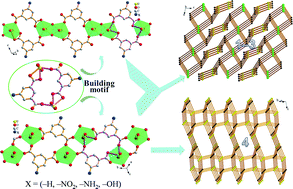A family of 3D UO22+–5-X-1,3-dicarboxylate (X = –H, –NO2, –NH2, –OH) hybrid materials: structural relevance with variation of substituent groups and photochemical properties†
Abstract
Four new 3D uranyl complexes, [(UO2)2(H2O)(ipa)2]·9H2O (1), [(UO2)2(H2O)(nip)2]·H2O·Et3NH (2), [(UO2)2(H2O)(aip)2]·Et3NH (3) and [(UO2)(hip)]2·17H2O (4) (H2ipa = isophthalic acid, H2nip = 5-nitroisophthalic acid, H2aip = 5-aminoisophthalic acid, H2hip = 5-hydroxyisophthalic acid, Et3N = triethylamine), were hydrothermally synthesized. Structural analyses reveal that compounds 1–4 consist of pentagonal bipyramidal uranyl monomers bridged via acid inkers to form a structural motif, [(UO2)2L2], serving as the foundation of the 3D framework. Two structural motifs adopt different arrangement modes to connect to two types of chains. For 1–3, uranium atoms and carboxyl groups being from two types of chains respectively are coordinated to build similar 3D frameworks, while for 4, one type of chain links to the 3D architecture by the bond of the uranium atoms and –OH of the 5-hydroxyisophthalic acid ligand. The different guest molecules and structure assemblies displayed by the four compounds are a function of the variation of substituent groups of 5-X-1,3-benzenedicarboxylic acid (X = –H, –NO2, –NH2, –OH). Furthermore, the photocatalytic properties of 2 and 4 for degradation of rhodamine-B (RhB) upon xenon lamp irradiation have been examined. Elemental analysis, infrared spectroscopy, DRS and luminescence properties were also discussed.


 Please wait while we load your content...
Please wait while we load your content...